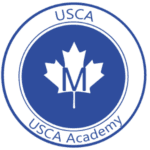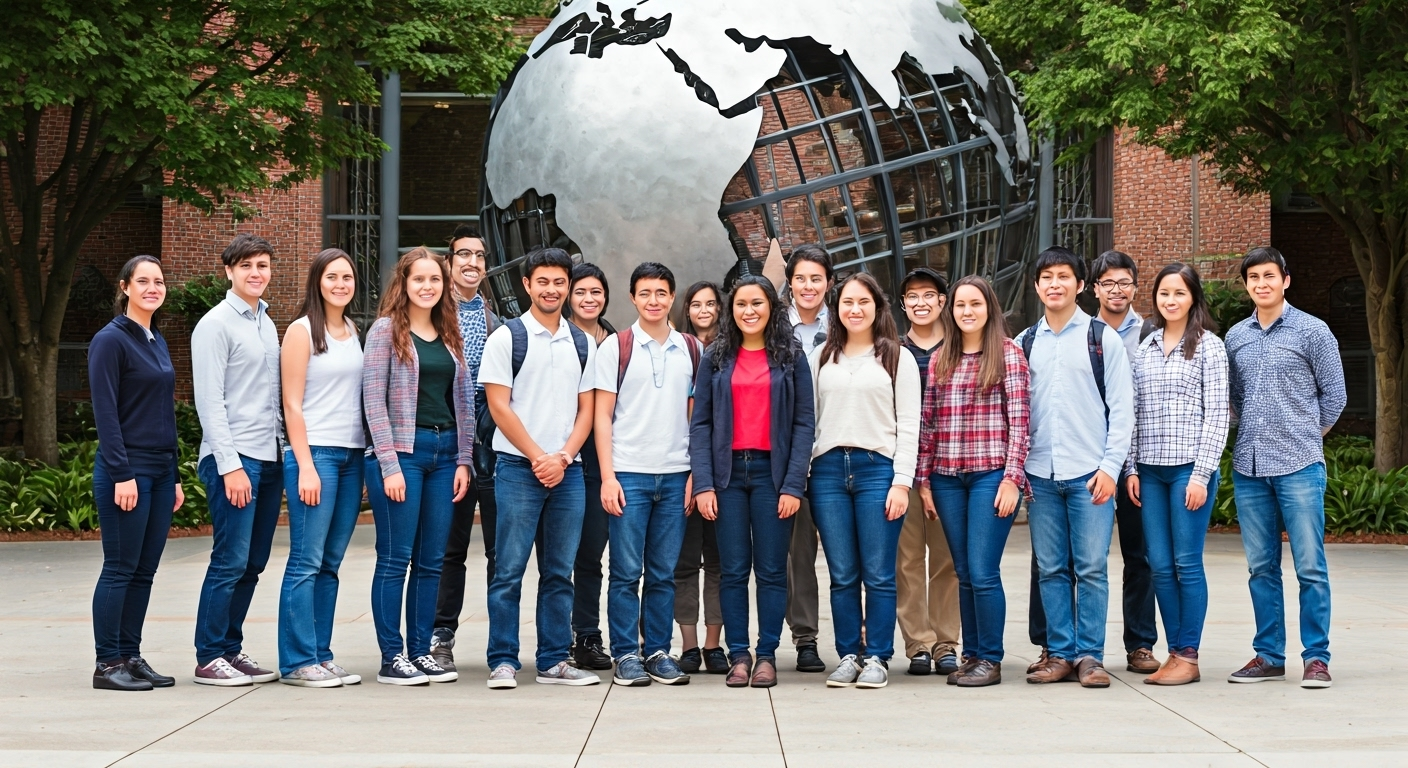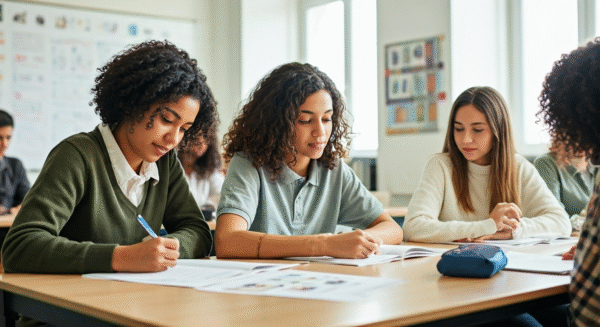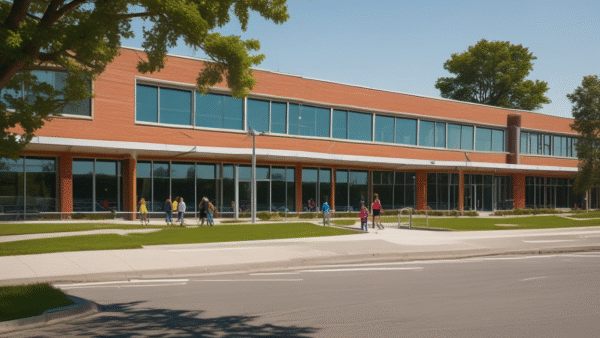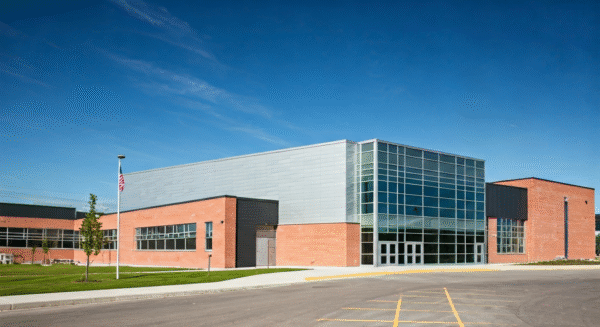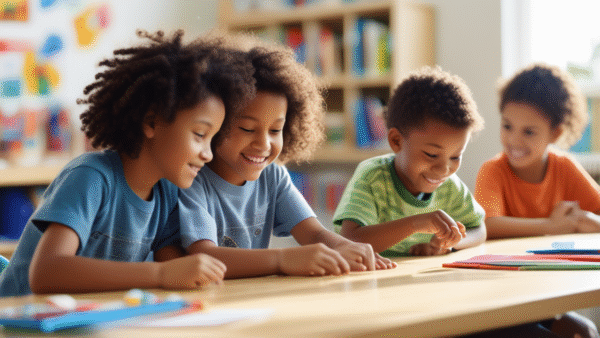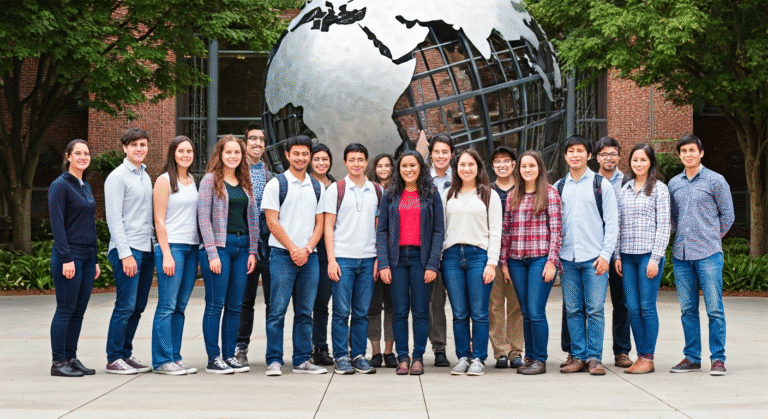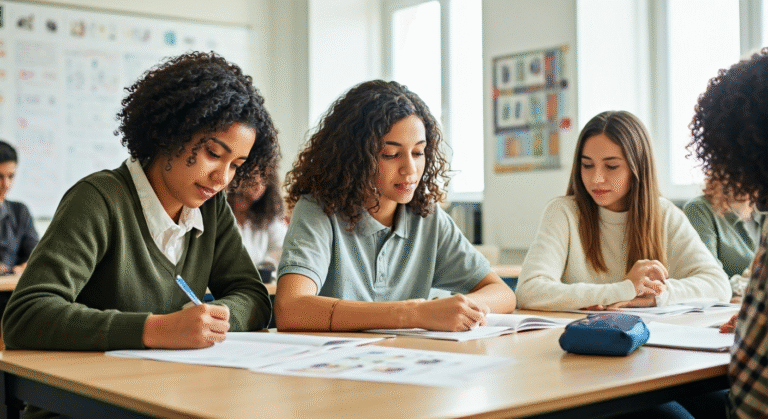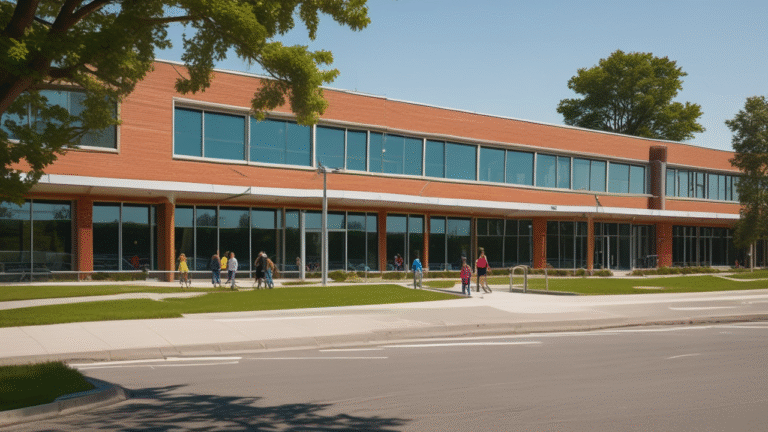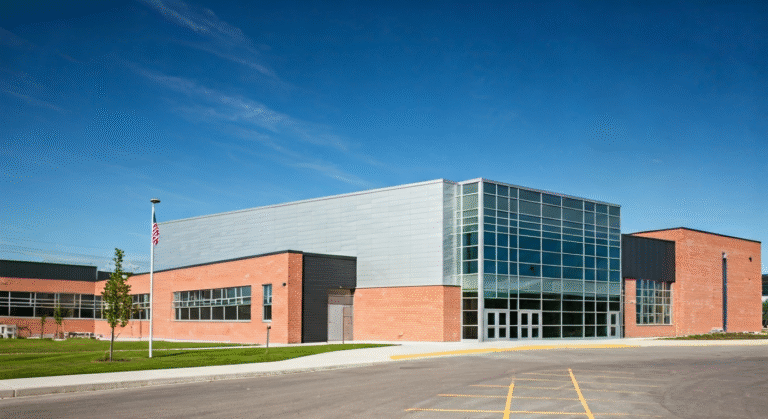Key Highlights of Educational Institutions
- Educational places, like international schools, are a big part of the global education system. These places include public schools, private schools, charter schools, and higher education like colleges and universities.
- There are a lot of choices in this area. Some schools help people learn special skills or job training. Some are international academies. USCA Academy is seen as a leader in K–12 education.
- Admission rules and academic programs are not always the same. They can be different for students from the same place and for international students.
- Many students use student loans, bursaries, and scholarships to get into higher education. These tools help students from all kinds of backgrounds to study.
- New education trends come from things like innovation, new technology, and mixing in-person and online classes. These changes are good for now and for the future.
- Good quality education helps all people. It makes the economy better, helps people get jobs, and builds strong communities all over the world.
Introduction
Staying up to date with education trends is what people need to do now. Schools everywhere, including ones like USCA Academy, are changing all the time. You see this in public schools, private schools, charter schools, and international schools. All kinds of educational institutions help to shape workers for the future. They make a country stronger. The benefits of education are not only about lessons from books. It helps people grow, get jobs, and live a better life in many ways.
Now, you can pick from many schools and colleges. Some, like USCA Academy, offer special programs that you may like. So, it is good to know how these places work. You should learn about their admission process and what kind of quality they give. This helps you make good choices for your learning. The more you know, the better it can be for your future.
Overview of Educational Institutions
Educational institutions are key to sharing knowledge and helping society move forward. In the United States and Canada, there are many places to learn for both local and international students. These schools help people take part in the global education system. Colleges and universities offer higher learning and skills training. They work with students from all over the world, so anyone can get closer to their goals.
In canada, an educational institution means a place where people can study and learn. It should be known, listed, or approved by the right people. A school like this can give degrees, diplomas, or certificates. These schools are not the same as other places. They have special rules to check the quality and the money. They also follow laws. This helps every student get what they need to learn in a good way.
What Is an Educational Institution?
An educational institution is a place that gives formal teaching. It can be for early childhood education, primary school, secondary school, or higher learning. The Government of Saskatchewan says these places must follow laws set in the province. Official translation also shows that you need to get approval or be registered by the law to give out academic certificates. Private educational institutions, public schools, universities, colleges, and vocational schools are all part of these groups in Saskatchewan.
Canadian law says that schools or groups must get approval, a license, or be certified if they want people to see them as real educational places for things like taxes, money help, or licenses. If the institutions are not regulated, they cannot give formal credentials. This is what makes them different from other groups that are not focused on academics.
The official translation, which you can find through the government of Saskatchewan web pages and other trusted sites, often puts text in a yellow box. This yellow box is to help people whose first language is not English understand these rules.
Educational institutions in Canada must teach what the law says and meet high standards for quality. They are not the same as businesses or local centers. This makes them very important for both learning and the future of the country.
Types of Educational Institutions
Educational places are not the same, but each one helps people in its own way. Public schools are where many start to learn and study. Private schools and charter schools teach in different styles with other topics that you can study. Colleges and universities have many academic programs to help people get better at their work or learn more in their field. These schools welcome both local and international students.
UNESCO puts schools into two main groups. The first group is called instructional institutions. These be the places where students get lessons in a classroom. Teachers show people what the students need to learn right then. The second group is non-instructional institutions. These do not give direct lessons to students. Instead, they help out by giving resources, doing research, or helping with office work. When you know this, you can better understand the work of schools all over the world.
K–12 / Schools (public, private, charter)
Schools for kindergarten to twelfth grade help kids learn the basics early on. Kids can go to public schools, private schools, or charter schools. These get kids into different ways to learn.
USCA Academy is a school that stands out. The way it teaches is much more than getting good grades. It also helps kids to grow in their feelings and how they act with people. The school shows why it is important to have teaching that can change for every student. They want everyone to be a part of it and feel included.
Public schools bring people together. They are a big part of local life. Private schools and charter schools, on the other hand, have special programs. These programs help with different things that students and their families want.
Higher Education (colleges, universities)
Colleges and universities play a big part in the global education system. They give people many academic programs and help them get ready for work and careers. In the United States, higher education is open to both local students and international students. This means more people can learn and grow. Ways of learning are changing every day.
A lot of these places now use distance education and online tools. This helps more students around the world join in and learn, no matter where they are. Bursaries and student loans also make it easier for people to go to school. These things give everyone, no matter what, a better and more open way to get an education. Life can move fast, but these supports help education keep up.
Vocational, Technical & Specialised Institutions
Vocational schools, technical colleges, and special programs help people learn skills they can use on the job. If you want to learn the skill of a professional translator, trade work, technology, or healthcare, these places give you what you need. Polytechnics and career colleges also offer programs that match what companies look for. You can find most of what they have to say on their web pages or in portable document formats like PDFs.
To get money from the government or be certified, schools must follow provincial rules. A school has to be registered, and the program needs to pass checks for good quality. Certified schools use official translation to help with many language groups. They must also keep their website content up-to-date and correct.
Saskatchewan Polytechnic welcomes international students. It has a job rate of 94% for people who finish school there. At this place, students have time in their classes and do real work as well. This way, they are ready to get a job right after they finish school. These schools in Saskatchewan help all the students move from learning in books to working in real jobs. They give a big boost to the local economy. They also help people start good careers.
Why Educational Institutions Matter
Good schools and colleges help the economy get better. They also help people live better lives. The benefits of education let people find jobs, bring new ideas, and help all people enjoy life more. It can make living standards better and help make local places stronger.
The number of teachers in a school or college, the things students can use, and how hard people work to do well can all change how students do in class. When schools and colleges have what they need and bring in all the people who are there, students often get better results. This can also help build good groups of people. It gives us strong workers who we need in the future.
Economic, Social, and Personal Benefits of Education
Education brings long-term benefits. These help people, the economy, and all of society. If you finish school from a good place, you get better jobs. You also help the economy go up.
- The good things about money are that there is more work that gets done. People with degrees also earn more cash.
- In society, you see more people getting involved in the community. There is also less unfairness among groups.
- For people, you build stronger skills in thinking. You get better at solving problems, and you feel better about your life.
- Studies say learning gets better when there are fewer students for each teacher. This usually happens in private educational institutions and public schools.
Statistics Canada says that 59% of people in Canada, between the ages of 25 and 64, have a college or university certificate or degree. Canada is ahead of all the other OECD countries in this area. Because more people in Canada go to school, there is good personal growth and people feel they can change jobs if they need to. Like Malcolm X said, “Education is the passport to the future, for tomorrow belongs to those who prepare for it today.”
How to Choose the Right Educational Institution
Picking a school in Canada is important for your future. You need to see how the admission works at the school. Look into the academic programs they offer and find out what help there is for international students. It is a good idea to check early childhood education choices as well. Think about student loans too. Make sure the school is approved. All these things can help you make a good choice.
If you are an international student, make sure to look at the certified schools list from Immigration, Refugees and Citizenship Canada (IRCC) before you send in your application. When you know these main points, you can choose a canada school that matches what you want and helps you do well.
Key Factors to Evaluate Before Enrolling
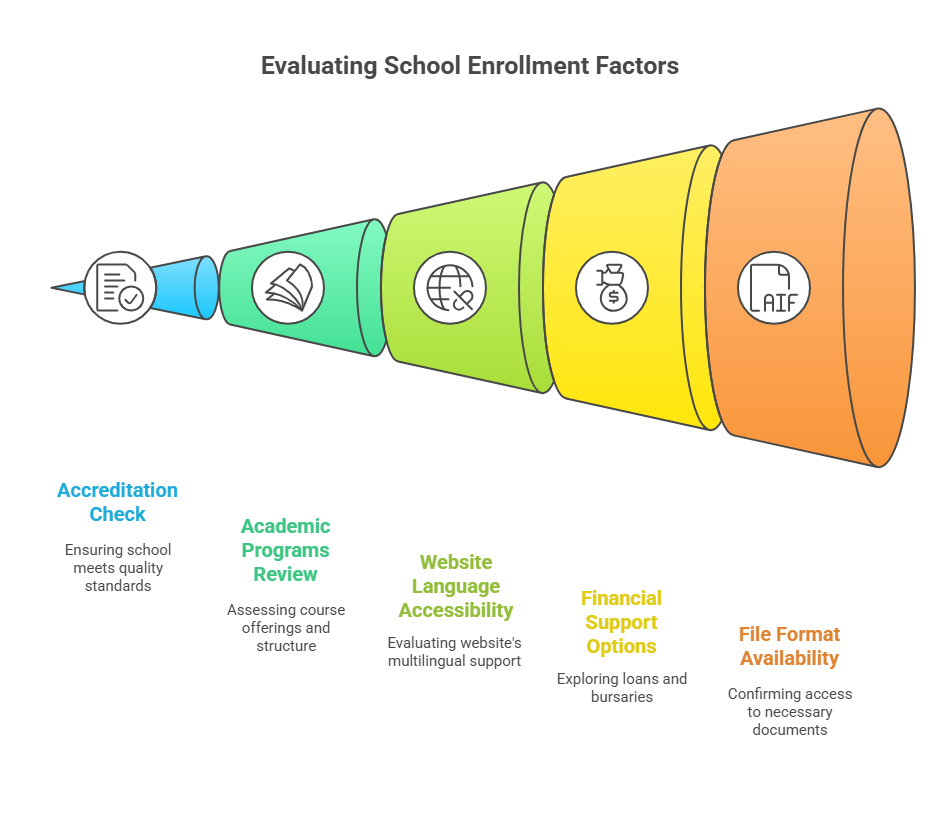
Assessing a school means you have to look at a few important things:
- Accreditation: Make sure that the school is approved. It should follow the needed quality rules so you know it’s a good choice.
- Academic programs: Check what subjects are offered. See how the classes work and how you can choose your courses.
- Translated website content: Find out if the website is set up in different languages. If English is not your first language, this helps a lot. Look at how many pages are there in your language.
- Financial support: Learn about student loans, bursaries, and other ways to get help paying for school.
- File formats: Make sure you can get what you need, like pdfs and transcripts. These should be simple to get and use.
To be a designated learning institution in Canada, the school must ask for approval from its province. A school gets checked in many ways and needs to show that it meets education rules. When a school has the accreditation, you can feel confident about its quality. Thinking about all these things will help you feel good and clear when it comes to picking your school in canada.
The 7-Point Checklist for Making the Best Choice
If you want to make a good choice, you should start with a careful check of the facts. Here is a simple list that can help you go step by step:
Key Factor | Why It Matter |
|---|---|
Accreditation Status | Verifies quality and legal recognition |
Program Offerings | Ensures alignment with career and learning goals |
Admission Requirements | Clarifies eligibility and preparation needed |
International Student Support | Helps with immigration, language, and adaptation needs |
Financial Aid Options | Increases affordability through loans and bursaries |
Facilities & Services | Improves the overall student experience |
Reputation & Outcomes | Indicates graduate employment and academic achievement |
The Directory of Educational Institutions in Canada, run by the Canadian Information Centre for International Credentials (CICIC), has a complete and up-to-date list. This is meant to help students who want to study in Canada, but people use the list at their own risk. For more answers about legal rules and paperwork, you can read the FAQs.
Current Trends & The Near Future (2024–2026)
New ways of learning are changing schools and colleges today. Distance education is now used more often. Better technology makes this possible. Now, international students can take part in classes from different places. A lot of academic programs use both in-person and online learning. This mix helps make learning more flexible for people.
Private educational institutions are bringing new ways to make secondary education better. They are teaming up with the federal government to help make it easier for people to pay for college and school. The help comes through things like student loans and bursaries. Now, there is a strong focus on making sure all people can get good education. As the world moves forward, there will be even more chances for us to study and grow together.
Technology and Hybrid Learning Models
Technology is changing how schools share lessons and course material. There is now hybrid learning that gives us many options. With distance education, you can use web pages and pdfs. This lets you get into academic programs any time. A lot more people can now take classes, and it is very handy for them.
- Hybrid models use both real classroom sessions and online lessons. This is good because people have different ways that they like to learn.
- Schools give out important materials as pdfs. This makes it easy for everyone, even international students, to get what they need.
- Institutions keep their website content up to date. They also offer translated website content, so all people, including international students, can read the information.
- Distance education is growing fast. It is getting more common in higher education and for job training. This means it will likely keep changing the way we learn in the future.
The Government of Saskatchewan says that when COVID-19 hit, lots of colleges and universities in Saskatchewan started to use web pages for student services. This change helped make things easier for students to get what they need. As digital tools keep getting better, higher education will use new technology more and more. This will help both home students and international students get better outcomes in Saskatchewan.
Growing Internationalization of Education
Internationalization is shaping how education works in Canada and other places. It helps grow French education too. Schools now help more international students. They offer website information in different languages. These schools also have special programs that follow global rules.
- More than 16% of the students in Canadian colleges and universities are international students. They come from 225 countries. These students often speak a first language that is not English.
- Schools in Canada that have approval from Immigration, Refugees and Citizenship Canada (IRCC) are listed where anyone can see. This helps international students find the right place to study.
- Students who do not have English as their first language get help from official translations and many other resources. These things make it easier for them to join in at the school, feel good, and take part in school life.
Schools like USCA Academy and Saskatchewan Polytechnic in Canada open doors to students from many places. They make sure students feel welcome. They help them get used to new things. They also offer credentials that are valued in different countries. This way, they make the education there open to all. Students feel ready to do well with people from many cultures.
Emphasis on Employability and Career Readiness
Schools and colleges now work to help students get ready for jobs. They offer courses that teach you real skills you can use in the real world. Some courses help you get the fluency of a native speaker and the skill of a professional translator. There are also STEM lessons and health training. These things match what employers look for today.
- Jobs after school, like the 94% rate at Saskatchewan Polytechnic, show that the right academic programs can help students get hired.
- Classes are made to match what employers and the job market want. This helps people get ready for work.
- Schools give career advice, help students find jobs, and offer internships.
- Programs are checked to make sure people get good job skills from these classes at the end. These checks also make sure the certificates meet the rules.
The government and many groups want schools to show how academic programs help students get jobs and do well at work. When schools make changes to their academic programs to match what people need in today’s world, it helps students do their best. This is also good for the economy and gives graduates the skills they need to succeed in new jobs later.
Expanding Accessibility and Inclusion Efforts
Accessibility and inclusion are important for schools and colleges in Canada. This is even more true right now because of the postal service disruption and the interruption des services postaux. The government of Saskatchewan ministries and Crown corporations work to help people. They try to make these problems less stressful for everyone in Canada.
- Schools and colleges now give more help and tools online. This includes translated website content and key files in ways that many can use.
- Student services are there for learners with disabilities, learners from groups that do not have many members, and people who find it hard to join in.
- The schools also team up with government groups. They do this so their news and information is always on time and true.
- Inclusion is about early childhood education, Indigenous education, and gender variety too.
Accessibility steps, like online counseling and remote support, help more people to take part in academic programs. These choices let everyone feel welcome. They make it so that every student can have a good chance to do well in school. A well-known quote from Nelson Mandela reminds us that “Education is the most powerful weapon which you can use to change the world.”
Conclusion
To sum up, schools, colleges, and learning centers help people and their communities grow. They give everyone a chance to learn and improve in life. K-12 schools, universities, and places like USCA Academy each offer something special for different needs. USCA Academy, for example, focuses on giving students a complete education. This helps them be ready for the future.
Technology now makes learning easier and helps more people get involved. These days, getting ready for work and jobs is an even bigger part of school. So, it is important to know how picking the right school or program matters. Your choice can affect your learning and what your life looks like later. Be sure to look at your options and choose a good place to study. A good education gives you more chances to learn and do well. If you want to start your next step in learning, contact us for a talk today!
Frequently Asked Questions
1. How do accreditation bodies ensure quality in educational institutions?
Accreditation bodies check every part of the government of Saskatchewan content. They make sure things like graphs and file formats are correct. These groups review schools. They want schools to follow rules for good quality. Institutions must match these rules to get approval from the government of Saskatchewan. This helps people avoid bad programs. It makes education better for everyone in Saskatchewan.
2. What’s the impact of teacher-to-student ratio on learning outcomes?
A lower teacher-to-student ratio in both public schools and private educational institutions is good for the students. When there are fewer students for each teacher, every student can get more help. This makes it easier for them to do well, take part in class, and get ready for what comes next in life, like school or work. People who study this say it is true many times.
3. Are international branch campuses considered separate educational institutions?
International branch campuses are like schools in the global education system, if the federal government gives them that title and they follow the local rules. This can change things for international students. It can affect how they enter the school, what kind of money they get, and what help is there for them when they look for approved certificates.
4. What is the difference between an educational institution and a learning center?
An educational institution is a place where you get formal teaching. It gives out degrees or awards that people know about. The work there must meet fixed quality rules. A learning center is different. It offers help to students, gives resources, or some tutoring. But it does not give out diplomas or degrees. UNESCO says these two are not the same because of what they provide and the rules they follow.
